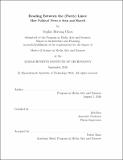| dc.contributor.advisor | Deb Roy. | en_US |
| dc.contributor.author | Chou, Sophie Beiying | en_US |
| dc.contributor.other | Program in Media Arts and Sciences (Massachusetts Institute of Technology) | en_US |
| dc.date.accessioned | 2017-03-20T19:08:37Z | |
| dc.date.available | 2017-03-20T19:08:37Z | |
| dc.date.copyright | 2016 | en_US |
| dc.date.issued | 2016 | en_US |
| dc.identifier.uri | http://hdl.handle.net/1721.1/107500 | |
| dc.description | Thesis: S.M., Massachusetts Institute of Technology, School of Architecture and Planning, Program in Media Arts and Sciences, 2016. | en_US |
| dc.description | This electronic version was submitted by the student author. The certified thesis is available in the Institute Archives and Special Collections. | en_US |
| dc.description | Cataloged from student-submitted PDF version of thesis. | en_US |
| dc.description | Includes bibliographical references (pages 107-110). | en_US |
| dc.description.abstract | This thesis uses mixed methods and datasets to explore how political news is perceived and shared within and across party lines in the context of the 2016 US presidential elections. We begin by examining the impact of political context versus article content on the reader through a crowdsourced study, and follow up with a large scale analysis of story sharing on the social platform Twitter to find cases where popularity transcends political affiliation. In Part One, we look at reader reactions. We investigate the question of trust in political news by performing a study online. We look at the impact of content features (reading level of the article) versus context clues (media brands) to find that political affiliation and brand outweigh all other aspects. In the second part of this thesis, we focus on reader actions. In particular, we look at how political news stories from the same time period are shared on the social media platform Twitter. As we found party loyalty and media brand perceptions to be significant influences on the reader's opinion of news, we are especially interested in examining emotional features that cause stories to become popular beyond political boundaries. Together, these two parts hope to form a more complete view of factors affecting and driving readers in an election cycle that is heavily influenced by media coverage, both traditional and new. | en_US |
| dc.description.statementofresponsibility | by Sophie Beiying Chou. | en_US |
| dc.format.extent | 110 pages | en_US |
| dc.language.iso | eng | en_US |
| dc.publisher | Massachusetts Institute of Technology | en_US |
| dc.rights | MIT theses are protected by copyright. They may be viewed, downloaded, or printed from this source but further reproduction or distribution in any format is prohibited without written permission. | en_US |
| dc.rights.uri | http://dspace.mit.edu/handle/1721.1/7582 | en_US |
| dc.subject | Program in Media Arts and Sciences () | en_US |
| dc.title | Reading between the (party) lines : how political news is seen and shared | en_US |
| dc.title.alternative | How political news is seen and shared | en_US |
| dc.type | Thesis | en_US |
| dc.description.degree | S.M. | en_US |
| dc.contributor.department | Program in Media Arts and Sciences (Massachusetts Institute of Technology) | en_US |
| dc.identifier.oclc | 974643576 | en_US |
